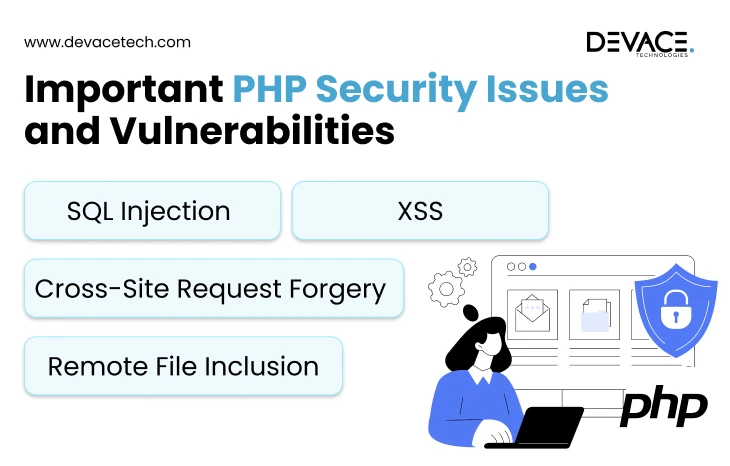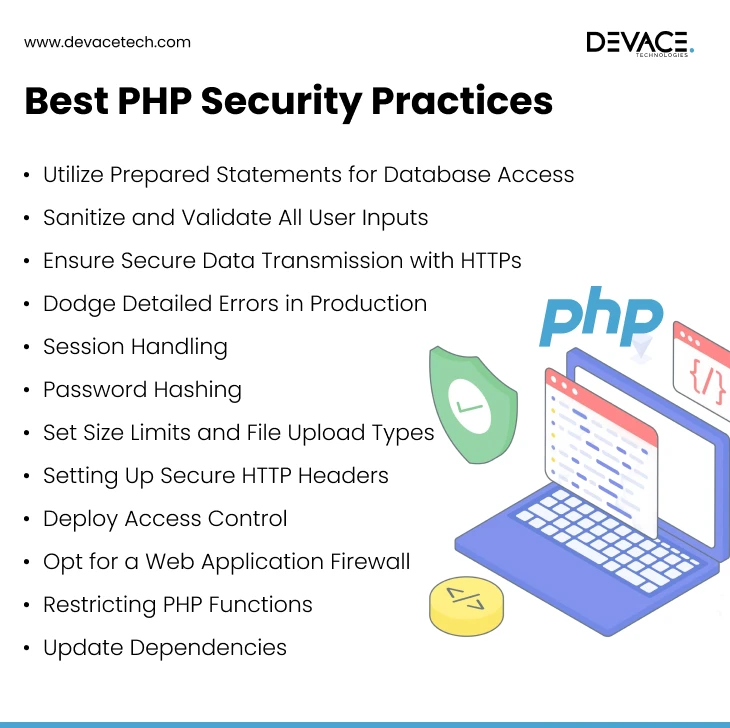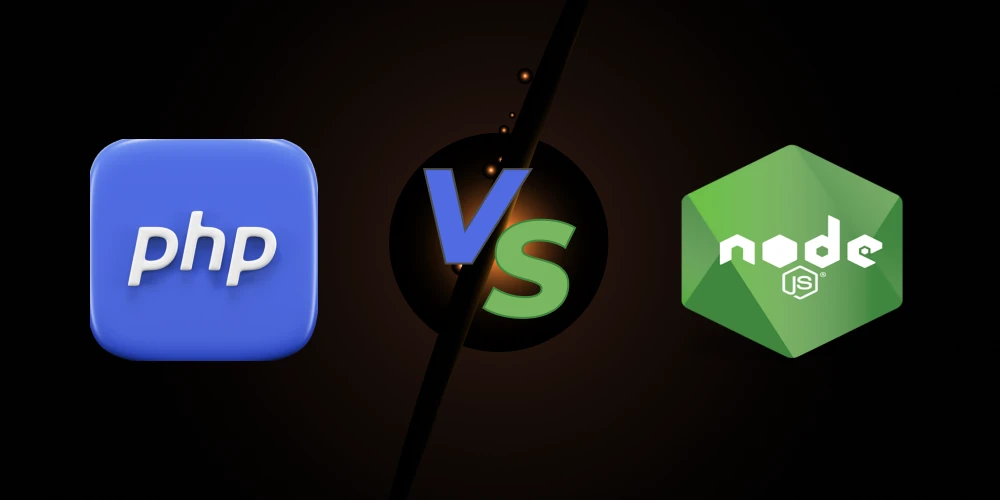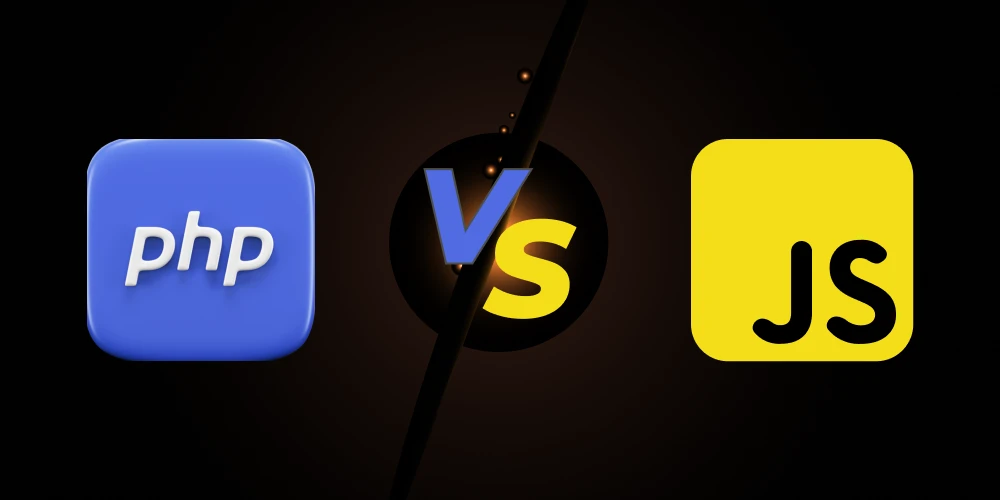The widespread use of PHP if comes with a lot of benefits it invites hackers’ attention. Your web projects can lead to a wide range of security vulnerabilities if they’re combined with insecure coding practices and common misconfigurations. Due to advancing cyber threats, it becomes crucial to adopt PHP security best practices for keeping your applications or websites safe. This blog will talk about all the PHP security issues and guide you on how to adopt the best PHP security practices to tackle such issues.
PHP Security Issues and Vulnerabilities
Some of the crucial PHP security issues include SQL Injection, Cross-Site Scripting, Cross-Site Request Forgery, and Remote File Inclusion. Let’s get into details:

1. SQL Injection
This type of PHP security vulnerability occurs when an attacker tries to insert a malicious SQL statement into your app’s query. It takes place when user inputs are not properly validated or sanitized. It results in potential leaking, deleting, or modifying data. Also, it allows unauthorized access to databases.
Example:
Here is an example of vulnerable code that might lead to SQL injection:
$ username = $_POST [‘username’ ]; $ password = $_ POST [ ‘password’ ]; $ query = “ SELECT * FROM users WHERE username = ‘ $username’ AND password = ‘$ password”, $ result = mysqli_query ($conn, $query);
Utilizing prepared statements to make sure that user input is considered and treated as data:
$ username = $ _ POST [ ‘username’ ] ??”;
$ password = $ _ POST [ ‘password’ ] ??”;
$ stmt = $ pdo -> prepare ( “SELECT * FROM users WHERE username = :username” );
$ stmt -> execute ([ ‘username’ = > $ username ]);
$ user = $ stmt - > fetch ();
if ( $ user && password _ verify ($ password, $ user [ ‘password’ ])) {
// Authentication successful
}
Are you planning to adopt advanced PHP security measures?
2. Cross-Site Scripting (XSS)
When client-side scripts are injected into web pages that other users view, you may face another type of PHP security vulnerability called Cross-Site Scripting. It enables attackers to impersonate users, steal session cookies, or redirect them to malicious websites.
Vulnerable code example:
$ _user _ input = $ _ GET [ ‘ user _ input’ ] ??” ; echo htmlspecialchars ($user _ input, ENT _ QUOTES | ENT _ HTML5, ‘UTF - 8’ );
3. Cross-Site Request Forgery (CSRF)
With CSRF attacks, users are tricked into making requests that they did not intend to make, and users are often unaware of it. To avoid this threat, you can use csrf token as given here:
if ( ! hash _ equals ( $_SESSION [ ‘csrf _ token’ ], $ _ POST [ ‘csrf _ token’
]??” ))
{ die ( ‘Invalid CSRF token’ );}
4. Remote File Inclusion
Attackers can include external files via a URL, and this is remote file inclusion. It can result in giving full control of your server to cyber attackers and in malicious script execution as well.
Vulnerable Code Example:
Such code can lead to remote file inclusion:
Include ( $ _ GET [‘page’]);
Secure Code Example:
Such secure code can be adopted to avoid a potential remote file inclusion threat:
$ whitelist = [ ‘home’ , ‘about’ , ‘contact’ ];
$page = $_ GET [ ‘page’ ]?? ‘home’ ;
if ( in _array ( $page , $whitelist ))
{ include DIR. “ / pages / { $page } . php”;} else { include DIR . “ / pages / 404 . Php” ;}
Best PHP Security Practices
Now, as you are familiar with PHP security issues, let’s get into some PHP best practices that you can follow to have secure web applications:

1. Utilize Prepared Statements for Database Access
For web app development, you can use prepared statements to have database access. This is one of the most effective ways to stay safe from SQL. Such prepared statements keep query logic separate from user-supplied data.
$ email = $ _ POST [ ‘email’ ] ?? ”; $ stmt = $ pdo -> prepare ( “SELECT * FROM users WHERE email = :email” ); $ stmt -> execute ([ ‘email’ = > $email ]); $ user = $ stmt -> fetch ( );
Moreover, instead of directly injecting variables into SQL strings, use MySQLi or PDO with bound parameters. You can hire PHP developers to keep web applications safe.
2. Sanitize and Validate All User Inputs
You should never trust any input blindly that comes from users. Validate all inputs for expected type, length, and format. Also, sanitize it to escape or easily remove harmful data.
You can follow the given code example:
$ email = filter _ input ( INPUT_POST , ‘ email ’ , FILTER _ VALIDATE – EMAIL ) ; $ age = filter_input ( INPUT _ POST, ‘ age ’ , FILTER_VALIDATE _ INT, [ ‘options’ => [ ‘ min _ range ’ = > 18 ]]);
3. Ensure Secure Data Transmission with HTTPS
One secure PHP practice is to follow is forcing HTTPS on all pages. This way it becomes possible to encrypt communication between users and server and resulting in prevention from man-in-the-middle attacks.
Follow this script:
RewritenEgine On RewriteCond % { HTTPS } != on
RewriteRule ^ https: // % { HTTP HOST } % { REQUEST URI } [ L , R = 301 ]
4. Dodge Detailed Errors in Production
With detailed errors, fraudsters can have access to your application’s inner workings. To stay safe, it is a good option to disable error display in production environments and enable error logging.
Here is how you can do it:
// Display of errors ini _ set ( ‘ display _ errors ’ , ‘ 0 ’) ; error _ reporting ( E _ ALL ); // Enable logging ini _ set ( ‘ log _errors ’ , ‘ 1 ’ ) ; ini _ set ( ‘ error _ log ’ , DIR. ‘/ logs / php _ errors . log’);
Moreover, you can consult a software development company to avoid detailed errors in production.
5. Session Handling
If session handling is not done properly, it may lead to session fixation and hijacking. Always create session IDs right after login and utilize secure flags:
session _ set _ cookie _ params ({
‘ lifetime ’ => 0,
‘ path ’ = > ‘ / ‘ ,
‘ domain ’ => $ _ SERVER [ ‘ HTTP _ HOST ’ ],
‘ secure ’ = > true,
‘ httponly ’ => true,
‘ samesite ’ = > ‘ Strict ’ ,
]);
session _ start ( );
session _ regenerate _ id ( true );
6. Password Hashing
To store user credentials in a secure manner, opt for secure hashing algorithms and never transmit or secure plain-text passwords.
An example to follow:
$ hash = password _ hash ( $ password, PASSWORD _ ARGON2ID ); //
Stronger than BCRYPT
// Verifying password if ( password _ verify ($ password , $hash )) {
// Logged in }
7. Set Size Limits and File Upload Types
To have secure web applications, limit the size and types of files you upload because uploaded files can be a major vector for cyberattacks.
$ allowed = [ ‘ jpg ’ , ‘ jpeg ’ , ‘ png ’ , ‘ pdf ’ ];
$ file = $ _ FILES [ ‘ file ’ ] ?? null;
if ($ file && $ file [ ‘error’ ] === UPLOAD _ ERR _OK ) {
$ ext = strtolower ( pathinfo ( $ file [ ‘ name ’ ] , PATHINFO _ EXTENSION
));
if (in _ array ( $ ext , $ allowed )) {
$ uploadDir =__ DIR __. ‘/ uploads /’;
$ newName = uniqid ). ‘.’. $ ext;
move_ uploaded_ file ($ file[‘tmp_name’] , $ uploadDir. $ newName);
} else {
die ( ‘Invalid file type.’ );
}
}
You can also hire experts from good web development agencies like Devace Technologies to consider these PHP security practices.
8. Setting Up Secure HTTP Headers
Many malicious activities can be prevented by setting up secure HTTP headers like Content-Security-Policy, Strict-Transport-Security, X-Content Type, and others:
header ( “Content - Security – Policy : default - src ‘ self ’; script - src ‘ self ’” ); header ( “X - Frame – Options : DENY ”); header ( “Strict - Transport – Security : max – age = 63072000; includeSubDomains; preload” ); header ( “X-Content – Type – Options : nosniff” ); header ( “Referrer - Policy : no – referrer – when – downgrade ” );
If you have budget constraints and difficult to manage technicalities, you can consider remote developers for hire to have a smooth and safe development process.
9. Deploy Access Control
You can also ensure role-based access control in custom PHP development so that users can have access to relevant features and data only. This will limit unauthorized access also:
if ( ! Isset ( $ SESSION [ ‘role’ ]) || $_ SESSION [ ‘ role ’] ! == ‘admin’ )
{ http _ response _ code (403);
exit (‘Access Denied’ ); }
10. Opt for a Web Application Firewall
With a web application firewall, it is easier to block any sort of attacks before they reach your PHP apps. Multiple services offer this protection, including ModSecurity, AWS WAF, and Cloudflare.
11. Restricting PHP Functions
If you think that what PHP is used for? There are countless domains, however, it is possible to limit dangerous PHP functions like shell_exec( ), and eval to minimize the risk of command errors via the disable_function directive in PHP:
disable_functions = exec, shell_exec, system, passthru, eval
12. Update Dependencies
Outdated versions of PHP and especially third-party libraries are considered goldmines for hackers. To avoid traps, always monitor vulnerability databases and use the latest and stable versions.
Conclusion
PHP security should not always be addressed after system breaches; it is something that should be kept in mind during the whole web development process. You can effectively eliminate most attack vectors by using prepared statements for database access, validating and sanitizing user input, setting secure HTTP headers, implementing access control, and adopting other best practices.
Are you facing difficulties in keeping your apps safe?
Frequently Asked Questions
What is SQL injection in PHP security?
This is a method used by cyber attackers to interfere with application queries to its database. SQL Injection occurs when web developers add user input into SQL statements without escaping or sanitizing.
How does PHP take care of web application security?
Various tools and practices are offered by PHP to deal with security issues. Such in-built features include password hashing, database abstraction layers, and data filtering. Developers can also leverage these features or advanced PHP frameworks like Laravel or Symfony to keep web applications secure.
What is a Vulnerability in the PHP context?
Any weakness or flaw in PHP code is called a PHP vulnerability. Such vulnerabilities can be exploited by cybercriminals to compromise a system. Some common vulnerabilities are SQL injection, cross-site request forgery, and cross-site scripting.






